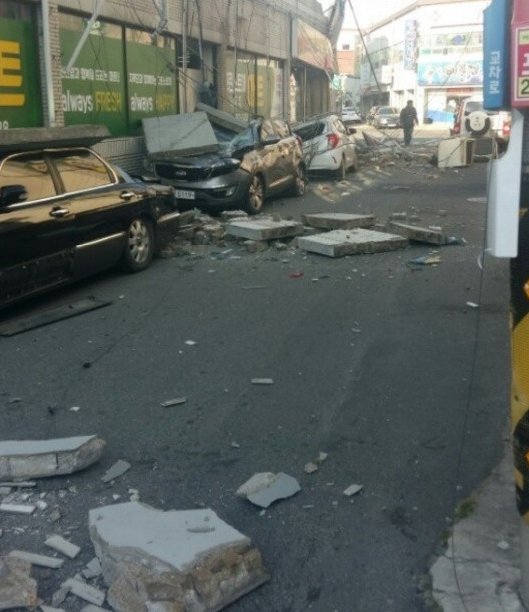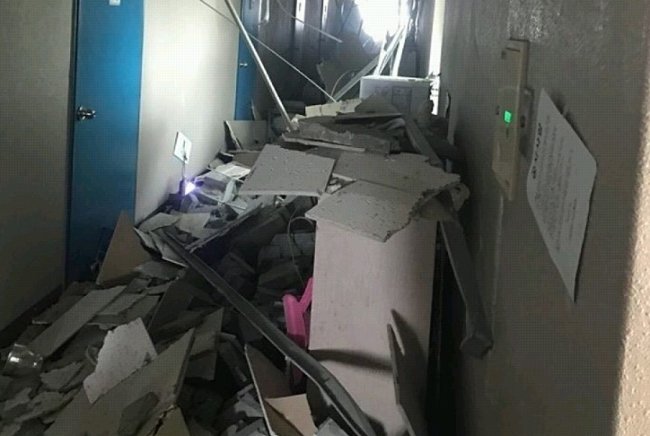Wednesday’s 5.4 magnitude quake in Pohang, North Gyeongsang Province, did not just shake the Earth. It shattered many South Koreans’ belief that their country is safe from devastating quakes.

It has been only 14 months since the long-held notion was first challenged by a rare -- so far the strongest -- 5.8 magnitude quake originating from Gyeongju.
“The front door of my house won’t open and my phone lost signal,” a Pohang resident wrote on an online community, where many shared their terrifying experiences during the series of strong tremors.
“I bolted out of my house, when I saw pots and plants crashing to the floor and the shoe cabinet falling over,” another resident wrote. “I couldn’t go back in for fear of additional quakes.”
Jo Jun-gil, head of the rural village of Mangcheon-ri in Pohang, said, “Many elderly residents are shocked. I visited each of their houses and told them to close the gas valve.”
Social media is being inundated with photos and videos of buildings shaking, books falling from shelves and frames falling off walls.
A video of students seen evacuating from the school building of Handong Global University in Pohang went viral. In that clip, a throng of people are seen rushing out of the building as its outer walls began to collapse. As of 6 p.m., the authorities said 10 people were hurt, but no casualties were reported.
The first quake of magnitude 5.4 hit north of Pohang at 2:29 p.m. About two hours later, the area was hit by another 4.6 magnitude quake. Pohang citizens were told to evacuate.
As of 6 p.m. Thursday, a total of nine quakes, two minor ones preceding the 5.4 magnitude quake, were recorded, the Korea Meteorological Administration said.
The main tremor was recorded as the second strongest after the 5.8 magnitude earthquake in Gyeongju in September 2016.
Tremors were felt in other parts of the country, including Seoul, about 270 kilometers away from Pohang, and the southern island of Jeju.
Hyun Jae-yeon, who was traveling on Jeju Island at the time of the earthquakes, found out about what had happened from a series of alert messages on her mobile phone.
“I felt the tremor about one minute after the emergency text message was sent to my phone. I do not think one minute is enough for people to evacuate to safe places,” said Hyun.
People in the capital also voiced concerns over a lack of preparedness for earthquakes.
“When my chair shook moments after receiving a text message about the earthquake, I felt unsafe here in Seoul and the country itself is horribly unequipped for earthquakes. Unfortunately, it feels like only a matter of time before a catastrophe strikes,” said Kim Jae-hoon, who felt an aftershock in Seoul on Wednesday.

There are public calls for the need to strengthen safety measures against earthquakes and prepare regulations on earthquake-resistant construction.
“I do not see any significant changes regarding the government’s preventive measures since last year’s Gyeongju earthquake. Like Japan, the government should make earthquake-proof construction design mandatory for all constructors,” said Yoo Jae-min, 37, a business man who runs a coffee shop in Busan.
The lack of earthquake-proof facilities across the nation are considered problematic.
According to the Ministry of Land, Infrastructure and Transport’s data, in 2015, just 26.7 percent of buildings three stories or over 13 meters high in Seoul were built based on earthquake-proof designs. The total figure across the country was slightly above 34 percent.
By Kim Da-sol (ddd@heraldcorp.com)


![[AtoZ into Korean mind] Humor in Korea: Navigating the line between what's funny and not](http://res.heraldm.com/phpwas/restmb_idxmake.php?idx=644&simg=/content/image/2024/04/22/20240422050642_0.jpg&u=)


![[Exclusive] Korean military set to ban iPhones over 'security' concerns](http://res.heraldm.com/phpwas/restmb_idxmake.php?idx=644&simg=/content/image/2024/04/23/20240423050599_0.jpg&u=20240423183955)
![[Herald Interview] Why Toss invited hackers to penetrate its system](http://res.heraldm.com/phpwas/restmb_idxmake.php?idx=644&simg=/content/image/2024/04/22/20240422050569_0.jpg&u=20240422150649)
![[Graphic News] 77% of young Koreans still financially dependent](http://res.heraldm.com/phpwas/restmb_idxmake.php?idx=644&simg=/content/image/2024/04/22/20240422050762_0.gif&u=)







![[Exclusive] Korean military to ban iPhones over security issues](http://res.heraldm.com/phpwas/restmb_idxmake.php?idx=652&simg=/content/image/2024/04/23/20240423050599_0.jpg&u=20240423183955)



![[Today’s K-pop] Ateez confirms US tour details](http://res.heraldm.com/phpwas/restmb_idxmake.php?idx=642&simg=/content/image/2024/04/23/20240423050700_0.jpg&u=)